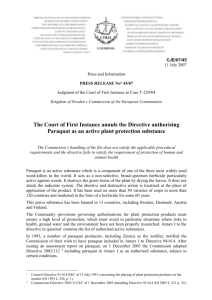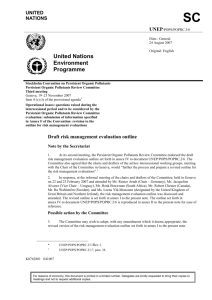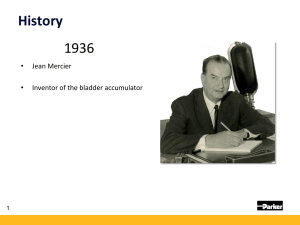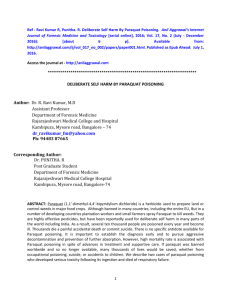Draft report - Rotterdam Convention
advertisement
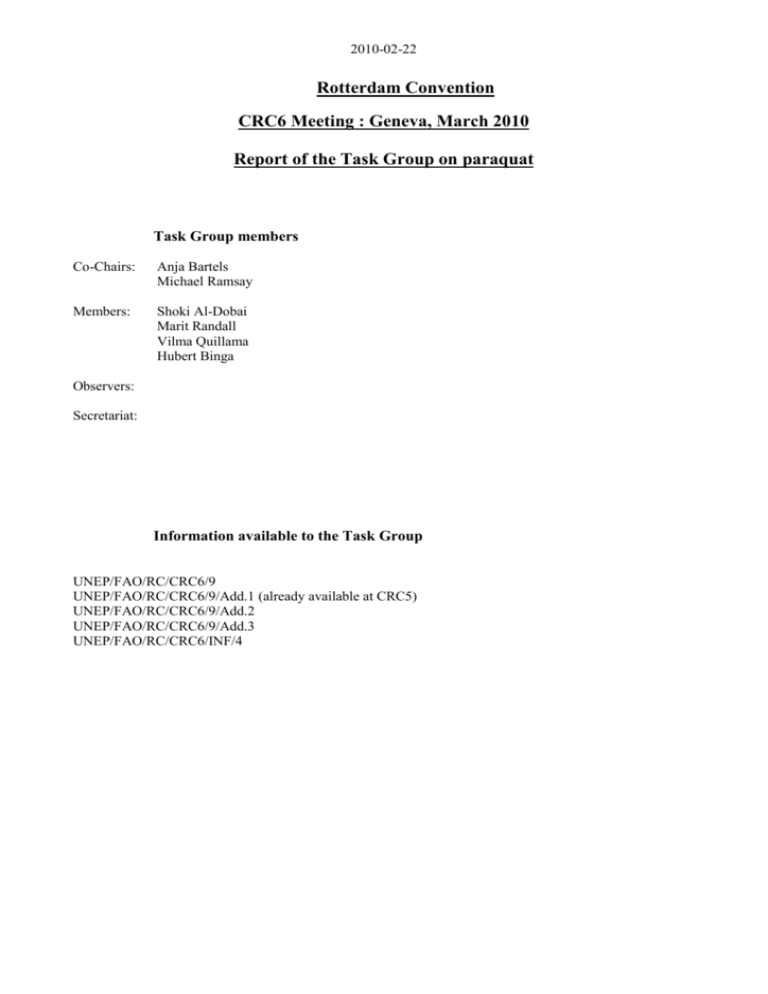
2010-02-22 Rotterdam Convention CRC6 Meeting : Geneva, March 2010 Report of the Task Group on paraquat Task Group members Co-Chairs: Anja Bartels Michael Ramsay Members: Shoki Al-Dobai Marit Randall Vilma Quillama Hubert Binga Observers: Secretariat: Information available to the Task Group UNEP/FAO/RC/CRC6/9 UNEP/FAO/RC/CRC6/9/Add.1 (already available at CRC5) UNEP/FAO/RC/CRC6/9/Add.2 UNEP/FAO/RC/CRC6/9/Add.3 UNEP/FAO/RC/CRC6/INF/4 2010-02-22 Introduction A notification from Sweden was available to the Committee together with supporting documentation from this country. The notification has undergone a preliminary review by the secretariat and the Bureau, who concluded that the notification did not appear to meet the criteria in Annex II to the Convention (document UNEP/FAO/RC/CRC6/3). The notification had already been available at CRC5 (UNEP/FAO/RC/CRC.5/8) and the Committee at that time concluded that adequate information that a risk evaluation had been conducted under the prevailing conditions in Sweden had not been provided. Accordingly, the task group had concluded that the criteria in Annex II (b) (i) and (ii) had been met but that the criterion in Annex II (b) (iii) had not been met. One member, being conversant with Swedish, had said that he had reviewed background documents in that language and had found that it did contain data confirming that the risk evaluation had been made in accordance with prevailing conditions in the country. After a discussion among Committee members Sweden was invited to resubmit its supporting information accompanied by an English translation, so that the notification could be revisited by the Committee at its sixth meeting. Since then the English translation and additional supporting documentation was received from Sweden (documents UNEP/FAO/RC/CRC6/9/Add.2 and UNEP/FAO/RC/CRC6/9/Add.3). The purpose of this report is to present the task group’s analysis of the Swedish notification together with the supporting documentation and to put forward a recommendation for the Committee’s consideration. The report is based on an annexed Excel spreadsheet analysing the notification of the party, which include a summary of the information provided in the notification (Article 5) and an analysis of compatibility with the criteria of Annex I and Annex II. The report contains an overall analysis, together with a recommendation to the Committee. 2010-02-22 Analysis of the Swedish notification Scope of the notified regulatory action: The notified regulatory action was to ban placement on the market and the use of paraquat as a pesticide. Paraquat has been used in Sweden as herbicide against weeds on arable land, in orchards and gardens and in plant nurseries; however, the use against quickgrass in potatoes was the dominating one. The regulatory action was mainly taken to protect human health (risk for adverse effects on human health and occupational safety) but also the environment (high persistence of paraquat in soil and sediment and possible effects on soil dwelling organisms). The notification was found to comply with the information requirements of Annex I. Information on socioeconomic effects of the action were also included in the notification and information on ongoing trade were later provided (UNEP/FAO/RC/CRC.6/9/Add.3). The following table and analysis sets out how the notification from Sweden meets the criteria of Annex II (see annexed Excel spreadsheet for cross reference to detailed information in the supported documentation). Criteria (a) (b)(i) (b)(ii) (b)(iii) (c)(i) (c)(ii) (c)(iii) (c)(iv) (d) Sweden Met Met Met Met Met Met Met Met Met Compatibility with the criteria of Annex IIa The regulatory action was taken to protect both human health and the environment (criterion Annex II a)). It was based on a hazard and risk evaluation taking into account exposure conditions of operators in Sweden. The risk for intoxication due to accidents when handling the substance during agricultural use was considered unacceptably high. It was estimated that mechanical failure of spraying equipment or protective clothing could lead to excessive exposure. In case of intoxication, no antidote or remedial cure exists, leading to unacceptable risk. The notification describes the specific risks and outlines that only a ban of paraquat use would significantly reduce the high risk to operators. Furthermore the high persistence of paraquat in soil and sediment and possible effects on soil dwelling organisms were considered of concern for the environment. Compatibility with the criteria of Annex IIb Annex IIb(i) and (ii) Establish that the final regulatory action has been taken as a consequence of a risk evaluation. This evaluation shall be based on a review of scientific data in the context of the conditions prevailing in the Party in question. For this purpose, the documentation provided shall demonstrate that: (i) Data have been generated according to scientifically recognized methods; (ii) Data reviews have been performed and documented according to generally recognized scientific principles and procedures; The Swedish Environmental Protection Agency sponsored a dossier on the toxicological profile of paraquat. This review and evaluation was conducted by the National Institute of Environmental Medicine and the Department of Occupational Medicine (Lund Hospital) and is based on published literature. The reference is U.G. Ahlborg, S. Skerving (1982) PARAQUAT – a discussion of toxicity and human risk. Statens Miljømedicinska Laboritorium Box 60208, 104 01 Stockholm / Yrkesmedicinska kliniken, Lasarettet 221 85 LUND. The Swedish Environmental Protection Agency further sponsored a literature study about the fate and effects of paraquat in agricultural soil. This complete literature review was done by the Swedish University for Agricultural Sciences and is based on published literature. The reference is Lennart Torstensson (1982), Litteraturgenomgång rørande herbiciden paraquats upptradande i mark och vatten. Sveriges Lantbruksuniversitet, Institutioen for mikrobiologi. 2010-02-22 Both reviews are available in English translation in UNEP/FAO/RC/CRC6/9/Add.1. The data have been clearly generated according to scientifically recognized methods and the reviews have been performed and documented according to generally recognized scientific principles and procedures. Annex IIb(iii) (iii) The final regulatory action was based on a risk evaluation involving prevailing conditions within the Party taking the action; Human Health: The main reason for the regulatory action was that the risk for intoxication due to accidents when handling the substance during agricultural use was considered unacceptably high. It was estimated that mechanical failure of spraying equipment or protective clothing could lead to excessive exposure. In case of intoxication, no antidote or remedial cure exists, leading to unacceptable risk. In addition, long-term low dose exposure during agricultural use could lead to adverse lung effects and single or repeated severe contamination of the skin could also lead to fatal poisoning. The dossier referred to several cases of poisoning from accidents involving paraquat sprayed for weed control. There were also two serious incidents in Sweden a couple of years before the final regulatory action was taken. Another fatal accident happened in Denmark in 1981, where similar conditions to Sweden can be assumed. In this accident in Denmark a woman died 8 days after accidentally having tasted a paraquat solution that was prepared for agricultural use. In UNEP/FAO/RC/CRC6/9/Add.2, the Swedish authority provides some further explanatory comments. The ADI (acceptable daily intake) for humans is 0-0.002 mg/kg body weight as reported in Ahlborg & Skerving (1982). This corresponds to 140 µg per day for a 70 kg person. In the above cited review it is also noted that dermal exposure from spraying paraquat may occur in the range of 300-3400 µg/h. A risk evaluation based on these figures makes clear that fatal poisoning when handling the substance during agricultural use may easily happen. Serious incidents in the past in Sweden and a neighboring country prove that this happened under the conditions prevailing in Sweden. Document UNEP/FAO/RC/CRC6/9/Add.2, annex 4, states that more than 600 deaths resulting from paraquat poisoning have been recorded since 1964 and confirms that serious poisoning incidents and individual deaths have also occurred in the Nordic countries. This document, a meeting report of the Swedish Products Control Board, concludes that the use of paraquat poses a substantial risk of serious harm in connection with exposure due to accidents during agricultural use, also in Sweden. To prevent similar cases in the future, Sweden decided to ban the use of paraquat containing products in agriculture. Accordingly the risk evaluation took into account the conditions prevailing in Sweden and it is concluded that criterion Annex II b has been met. Environment: The high persistence of paraquat in soil and sediment and possible effects on sediment dwelling organisms were considered a matter of concern. Swedish field trials have been conducted to assess the persistence of paraquat in Sweden after normal agricultural use and showed that after 250 days no degradation had occurred. Swedish studies showed effects on soil dwelling organisms (springtails, mites). It was considered that continued use of paraquat in Sweden could lead to accumulation of the compound in the soil, especially in soils with high clay content, and that this poses an inacceptable risk to the environment. Such adverse properties with regard to the environment were an additional reason for the decision to ban the use of paraquat containing products in agriculture. Compatibility with the criteria of Annex IIc Annex IIc(i)-(iv) Consider whether the final regulatory action provides a sufficiently broad basis to merit listing of the chemical in Annex III, by taking into account: (i) Whether the final regulatory action led, or would be expected to lead, to a significant decrease in the quantity of the chemical used or the number of its uses; (ii) Whether the final regulatory action led to an actual reduction of risk or would be expected to result in a significant reduction of risk for human health or the environment of the Party that submitted the notification; (iii) Whether the considerations that led to the final regulatory action being taken are applicable only in a limited geographical area or in other limited circumstances; (iv) Whether there is evidence of ongoing international trade in the chemical; All uses as pesticide were prohibited, and information on paraquat sales in Sweden was provided (UNEP/FAO/RC/CRC6/9/Add.2, annex 6) showing that the quantities used were reduced from about 5000 kg active substance per annum in the period 1976 to 1983 to zero in 1984 and 1985. Hence the final regulatory action led to a decrease to zero of the quantities of the chemical used (c(i)) and in consequence to an actual reduction of the risk to human health and the environment (c(ii)). The considerations that led to the regula- 2010-02-22 tory action are generally applicable to other countries and are related to the intended use conditions as a pesticide (c(iii)). Sweden further argues that the high risk for irreversible effects on human health makes paraquat especially dangerous for use in home gardening and by consumers in general. The conditions of use in many developing countries increases the risks as high temperatures may lead to inadequate use of protective clothing. As information on the quantities used is available and paraquat has not been produced in Sweden, it can be concluded that there is evidence of ongoing trade (criterion c(iv)). Hence it is concluded that the criteria of Annex IIc are met. Compatibility with the criteria of Annex IId (d) Take into account that intentional misuse is not in itself an adequate reason to list a chemical in Annex III. There is no indication in the notification that concerns for intentional misuse were the sole or main reason for the regulatory action. It is clearly stated that concerns were related to the risk for intoxication due to accidents when handling the substance during agricultural use. Accordingly the criteria of Annex IId are met. Conclusion The task group concluded that the notification of regulatory action from Sweden met the information requirements of Annex I and the criteria set out in Annex II of the convention. Recommendation Consequently, the Task Group recommends that the Chemical Review Committee conclude that the above discussed regulatory action notification from Sweden has met the criteria set out in Annex I and Annex II. CRC to draft a rationale to document that the notification from Sweden meets all the criteria of Annex II.


